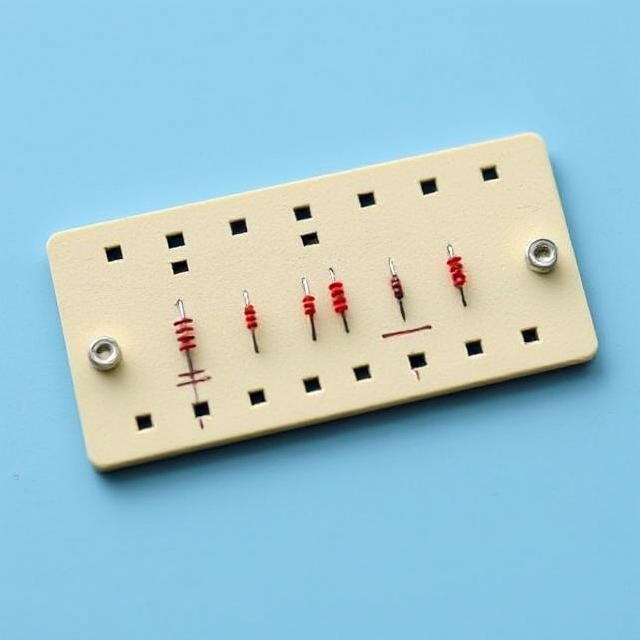In electronics, resistors are essential components used to manage and limit the flow of electrical current. By arranging resistors in specific configurations, we can perform useful tasks like adjusting voltage levels, distributing current, or conditioning signals. Among these configurations, resistor networks and voltage dividers are some of the most fundamental and widely used.

1. Resistor Ladder Networks
A resistor ladder network is a linear arrangement of resistors connected in series, often used to generate specific voltage levels.
How It Works
In a ladder configuration, the voltage drops across each resistor evenly (assuming equal resistance), allowing you to tap into different voltage levels at various points. This is commonly used in:
-
Digital-to-Analog Converters (DACs)
-
Analog-to-Digital Converters (ADCs)
-
Voltage reference circuits
Example
Imagine you have a 9V power supply and three identical resistors. If each resistor drops 3V, you’ll get:
-
3V at the first tap
-
6V at the second tap
-
9V at the end of the ladder
This allows easy access to multiple voltage levels from a single power source.
2. Voltage Divider Rule and Its Applications
The Voltage Divider Rule is used to calculate the voltage drop across any resistor in a series circuit. It’s a simple yet powerful concept based on Ohm’s Law.
Formula
-
V_in = Total input voltage
-
V_out = Output voltage across resistor R₂
-
R1 and R2 = Two resistors in series
How It Works
When two resistors are connected in series, the input voltage splits between them in proportion to their resistance values.
Example
Suppose:
-
V_in = 12V
-
R1 = 2kΩ
-
R2 = 4kΩ
So, the voltage across R₂ would be 8V.
Common Applications
-
Adjusting Voltage Levels: Scale down voltage for sensors or logic circuits.
-
Signal Conditioning: Modify voltage signals for input into other stages.
-
Biasing Transistors: Set the correct base voltage for operation.
3. Using Resistor Networks for Signal Conditioning
Signal conditioning involves preparing electrical signals for processing. Resistor networks play a key role in this by controlling signal strength or filtering noise.
How They Help
Resistor networks can:
-
Control signal amplitude (attenuation)
-
Combine with capacitors to create filters (e.g., low-pass filters)
-
Match voltage levels between components
Example
In an audio system, resistor networks help adjust volume levels or reduce signal amplitude before amplification.
4. Custom Resistor Networks for Specific Circuit Needs
Standard resistor networks may not always meet the needs of specialized circuits. In such cases, custom resistor configurations are used.
Use Cases
-
Precise Voltage Drops: For voltage reference or scaling.
-
Multiple Output Levels: Generate different voltages from one input.
-
Adapt to Unique Loads: Meet specific current or voltage demands.
Example
In a temperature sensing circuit, the sensor output voltage may not be in the ideal range for an ADC. A custom resistor network can scale this voltage into the acceptable range for accurate measurement.
5. Practical Examples of Voltage Dividers in Circuits
Let’s look at real-life scenarios where voltage dividers are essential:
Example 1: Adjusting Sensor Outputs
Many sensors output voltages higher than a microcontroller can handle. A voltage divider brings the signal within a safe range.
-
Problem: Sensor outputs 5V; microcontroller accepts max 3.3V
-
Solution: Use a voltage divider to scale 5V down to 3.3V
Example 2: Power Supply Regulation
Voltage dividers can derive lower voltages from a higher supply for different circuit sections.
-
Use case: Convert 5V to 3.3V for a specific component
Example 3: Signal Attenuation
If an input signal is too strong, it can damage sensitive circuits. Voltage dividers help reduce its strength.
-
Use case: Lower audio signal before input to a microphone preamplifier
Summary
| Topic | Key Points |
|---|---|
| Resistor Ladder Networks | Series of resistors to create multiple voltage taps. Useful in DACs and ADCs. |
| Voltage Divider Rule | Calculates voltage drop across resistors in series using a simple formula. |
| Signal Conditioning | Resistor networks adjust, scale, or filter signals for proper circuit operation. |
| Custom Resistor Networks | Designed to meet specific circuit needs like multiple outputs or precise scaling. |
| Practical Applications | Used in sensor circuits, power supplies, and signal attenuation for safe and reliable operation. |
Conclusion
Resistor networks and voltage dividers are fundamental to modern electronics. They allow engineers and hobbyists alike to control and manipulate voltage and current with precision. From scaling sensor signals to creating voltage references, these tools are versatile, powerful, and easy to implement. Understanding their principles opens the door to designing smarter, more efficient circuits.











